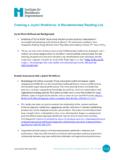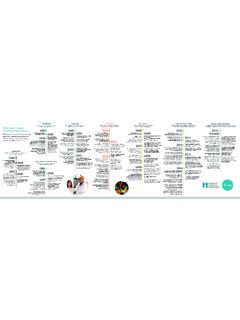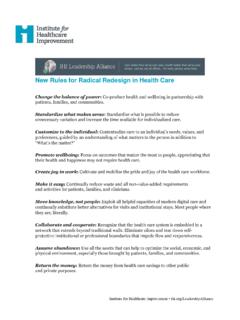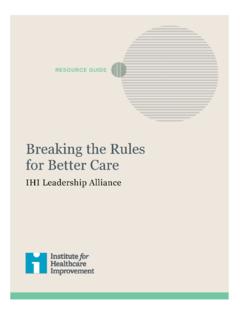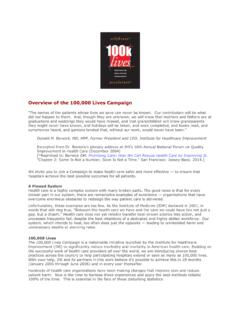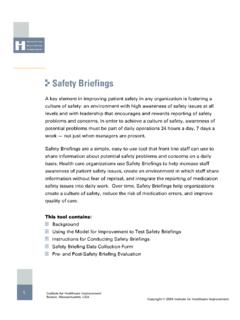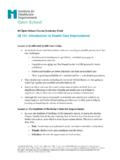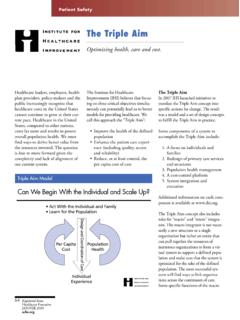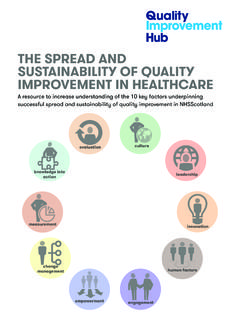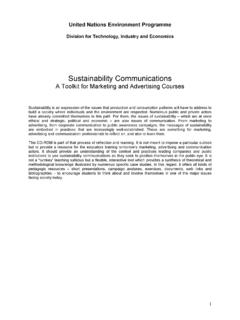Transcription of How-to Guide: Sustainability and Spread - IHI Home Page
1 Getting Started Kit: Sustainability and Spread How-to Guide A national initiative led by IHI, the 5 Million Lives Campaign aims to dramatically improve the quality of American health care by protecting patients from five million incidents of medical harm between December 2006 and December 2008. The How-to Guides associated with this Campaign are designed to share best practice knowledge on areas of focus for participating organizations. For more information and materials, go to Copyright 2008 Institute for Healthcare Improvement All rights reserved. Individuals may photocopy these materials for educational, not-for-profit uses, provided that the contents are not altered in any way and that proper attribution is given to IHI as the source of the content.
2 These materials may not be reproduced for commercial, for-profit use in any form or by any means, or republished under any circumstances, without the written permission of the Institute for Healthcare Improvement. How to cite this material: 5 Million Lives Campaign. Getting Started Kit: Rapid Response Teams. Cambridge, MA: Institute for Healthcare Improvement; 2008. (Available at ) This How-to Guide is dedicated to the memory of David R. Calkins, MD, MPP (May 27, 1948 April 7, 2006) -- physician, teacher, colleague, and friend -- who was instrumental in developing the Campaign s science base. David was devoted to securing the clinical underpinnings of this work, and embodied the Campaign s spirit of optimism and shared learning.
3 His tireless commitment and invaluable contributions will be a lifelong inspiration to us all. 5 Million Lives Campaign How-to Guide: Sustainability and Spread 2 Campaign Donors The 5 Million Lives Campaign is made possible through the generous leadership and support of America s Blue Cross and Blue Shield health plans. IHI also acknowledges the support of the Cardinal Health Foundation, and the support of the Blue Shield of California Foundation, Rx Foundation, the Aetna Foundation, Baxter International, Inc., The Colorado Trust, and Abbott Fund. This initiative builds on work begun in the 100,000 Lives Campaign, supported by Blue Cross Blue Shield of Massachusetts, the Cardinal Health Foundation, the Rx Foundation, the Gordon and Betty Moore Foundation, The Colorado Trust, the Blue Shield of California Foundation, the Robert Wood Johnson Foundation, Baxter International, Inc.
4 , The Leeds Family, and the David Calkins Memorial Fund. 5 Million Lives Campaign How-to Guide: Sustainability and Spread 3 General Introduction When IHI launched the 5 Million Lives Campaign in December 2006, we committed to partner with participating hospitals to protect patients from 5 million incidents of medical harm over the subsequent 24 months. Since then, hospitals have adopted and Spread the Campaign s interventions at different rates some starting with only one intervention in one unit, others introducing all twelve interventions across their entire facility or system. Having made such a significant investment in introducing the Campaign interventions, it is vitally important that participating hospitals plan to sustain and Spread improvements.
5 This guide identifies well-tested approaches for pursuing those goals: Sustainability : Locking in the progress that hospitals have made already and continually building upon it; and Spread : Actively disseminating best practice and knowledge about every intervention and implementing each intervention in every available care setting. 5 Million Lives Campaign How-to Guide: Sustainability and Spread 4 Sustainability (Holding the Gains) and Spread (Spreading Campaign Interventions to All Locations) On one of the Campaign team s many trips out into the field, a nurse at a hospital in the Detroit area noted that, from her standpoint, Collecting improvement data is just as important as taking vital signs it all contributes to better care for the patient and that is the goal of our work.
6 There is really no end to the improvement we can do, and our leadership expects us to make it a priority. Her statement was striking to those of us who heard it, and a source of great optimism an organization whose staff expresses such sentiments is one that understands the importance of continuous improvement and that has built the culture and the systems for sustaining progress indefinitely. Our goal is to build on the great successes we have observed in participating hospitals to this point and generate organizational capacity for change of the kind that s present at the hospital described above, describing key strategies and tactics for Sustainability or holding the gains and Spread in Campaign hospitals.
7 5 Million Lives Campaign How-to Guide: Sustainability and Spread 5 Why Is Sustaining and Spreading Progress So Important? By embarking on the 5 Million Lives Campaign, all of us IHI, our partners, Nodes and, above all, participating hospitals made a pledge to patients and families that we would change the standard of health care in the country, radically reducing harm and death through the introduction of the twelve Campaign interventions. We cannot afford to backslide on this pledge if we fail, patients will endure pain and families will lose loved ones unnecessarily. Furthermore, in an industry that is plagued by negative press coverage and pessimism, it is crucial that we do not lose momentum and sow deeper frustration.
8 Through the Campaign and other concurrent quality initiatives in the country hospitals have demonstrated that they are bringing the same passion to their improvement work that they bring to their patients each and every day. Reverting to prior levels of performance would damage the morale of those who have worked so hard to enhance their hospitals performance, and also send a message to critics that well-documented variability in American health care is difficult if not impossible to fix. While we know that this is not the case and that outstanding, ongoing performance is possible, we must prove it by building on the momentum of the last 21 months. Finally, our work on improving health care offered in participating hospitals has only just begun.
9 We are not yet where we need to be on all twelve Campaign interventions and won t be until every hospital in the country introduces them reliably. And our work doesn t stop there. There are countless other areas for improvement, and so it is critical that we establish the twelve Campaign interventions as new standards of care, and move on to new evidence-based interventions and areas for improvement. 5 Million Lives Campaign How-to Guide: Sustainability and Spread 6 PART ONE: Key Components of Sustainability (Holding the Gains) Authoritative sources on Sustainability in health care systems (see Sustainability Resources and Literature on p. 15) seem to agree that several or all of the following properties exist in organizations that sustain improvement: 1.
10 Supportive Management Structure 2. Structures to Foolproof Change 3. Robust, Transparent Feedback Systems 4. Shared Sense of the Systems to Be Improved 5. Culture of Improvement and a Deeply Engaged Staff 6. Formal Capacity-Building Programs For each of these components of a hospital s system for Sustainability , we have identified some notable best practices and examples of success. Examples come from our experience working with hospitals in the 100,000 Lives Campaign, the predecessor to the 5 Million Lives Campaign. 5 Million Lives Campaign How-to Guide: Sustainability and Spread 7 1. Supportive Management Structure In order to support Sustainability , the hospital s leadership (trustees and executives) treats quality of care as a high priority, devoting regular attention, creating accountability systems for improvement, and recognizing the organization s successes.
